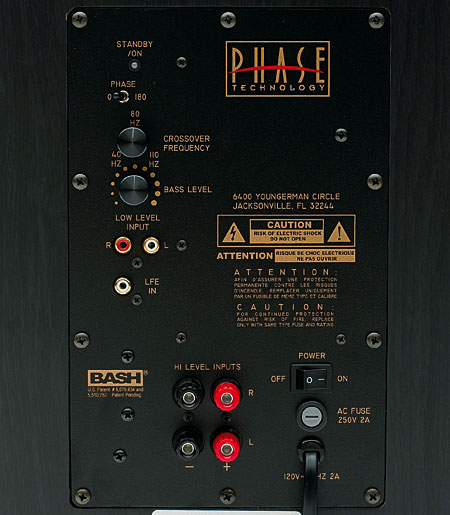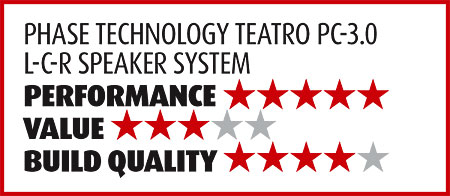Phase Technology Teatro PC-3.0 L-C-R Speaker System Page 2
The Teatro system’s soundfield—including the three front channels built into a single bar—was spacious. It extended well beyond the outer edges of the speaker, which was especially noticeable with percussion instruments. Vocal clarity was exemplary. The FL-10 sub reflected the mixer’s preference for deep but controlled pitches in music and even in explosions.

Where the system fell down, albeit rarely, was in the integration of the front and surround channels. I didn’t always notice it—because most surround mixes rarely feature identical front and surround information. But in the rainfall that envelopes one scene, it was obvious that there were tonal shifts between front and rear. In fact, Phase Technology has developed a new surround speaker with matching drivers to complement the Teatro. It wasn’t available at press time but will hopefully improve matters of timbre matching. It will also cost less than the Velocity V-Surround.
War, Inc.’s creative team liked its explosions wild and sloppy, which was very evident when I watched it back to back with Traitor. The Blu-ray Disc’s Dolby TrueHD soundtrack was cruder in every respect, a truth that the Teatro was scrupulous enough not to varnish. The overall volume level was higher and less dynamically varied. This suggests that even Dolby TrueHD gets mud in its eye when it’s dragged into the loudness wars. Again, I was grateful for the sub’s bloat-free nature, without which this intermittently unfunny comedy would have been a trial. The only scenes that made me smile were the ones with Joan Cusack. Her ever-mobile face is comedy personified. Someday she will join Carole Lombard and Gracie Allen in comedy heaven, but not soon, I hope.
Rudy features Sean Astin in the true story of a Notre Dame football legend. It was released in 1993, eight years before Astin became a Hobbit in Lord of the Rings, and it shows him as an involving and ingratiating lead actor. This Blu-ray Disc’s high-resolution PCM soundtrack contains some awesome surround effects, including the roar of a steel mill (at various levels of intensity). Of course, the roar of the crowd is a significant element, one that both the mixer and the Teatro exploited impressively. And the University of Notre Dame Glee Club serenades the climactic athletic scenes with manly gusto. This best-case material gave the Phase Technology set several chances to shine, and it never blew a single opportunity.
From Oslo to San Francisco to Venice
Goodnight Oslo, the new CD by Robyn Hitchcock & the Venus 3, gave the Teatro a chance to extract nuggets from a deliberately mellow mix—one that seemed designed to blunt the nervy top end of Hitchcock’s voice and his Fender Telecaster. In the standout track “I’m Falling,” massed vocals leaped out of the soft domes in a sudden access of beauty that’s like watching sunflowers blossom in time-lapse photography. I tried the vocal-enhancing toggle on the front panel, and it brought Hitchcock’s voice farther forward. The effect was far from crude or irritating. Side-to-side movements on the sofa showed the effects of the side-mounted Spatial Field Expander drivers. When my head was aligned with the speaker’s side edges or farther out, the soundstage elongated slightly, although it was perfectly satisfying at front and center.
Thelonious Monk’s Thelonious Alone in San Francisco, in the original JVC-Japan CD, seemed like a good opportunity to show what the Teatro could do in stereo with a simple but well-made piano recording. This shut down the center tweeter, midrange, and woofer, but it kept the front left and right arrays going, as well as the Spatial Field Expander drivers on the cabinet’s sides. The speaker was quite consistent in both the vertical and horizontal planes, except for the side-edge-and-beyond effect noted above.
I may seem to mention Vivaldi’s The Four Seasons pretty often—and in fact, I do revere the red-haired Venetian priest, partly for his influence on Bach. But it’s a different recording every time, I swear. The latest one to come over the transom is an SACD from the Boston Baroque with music director Martin Pearlman and violin soloist Christina Day Martinson. When I say that the period-instrument string sound got a strongly detailed treatment, that may sound like a recipe for listening fatigue. With a crudely voiced tweeter, it might have been. But it was also highly refined and had a gossamer lightness, like a spider web seen in bright sunlight. The highlight, far and away, was the Adagio from “Autumn,” a sublime shimmer of sound that revealed the bar’s impressive low-level resolution.
Phase Technology’s Teatro PC-3.0 L-C-R is one of the few high-end choices in its category. Since it requires surrounds to complete the soundfield and a sub to firm up the bass, it may not appeal to those who want a one-piece surround solution. Then again, many other soundbars also require subs, so how many of them are truly self-contained systems?
It impressed me that the Teatro can produce a front soundstage as refined, intelligible, and just plain great-sounding as any other bar out there, and it even competes effectively with high-quality conventional speaker packages in that respect. Here’s what happens when a manufacturer with a formidable pedigree approaches the soundbar genre. This is one bar a guy could like walking into.

- Log in or register to post comments




































































